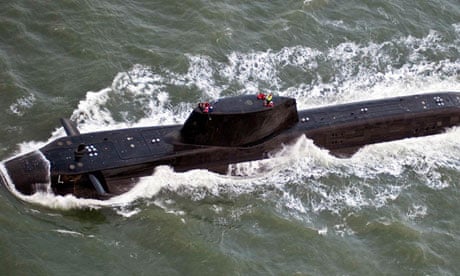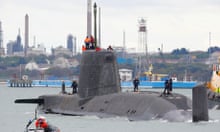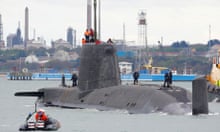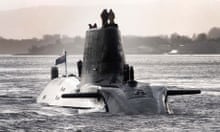The problems with the cost and delivery of Britain's new nuclear-powered hunter-killer submarines were set out in uncompromising detail in a report published by the National Audit Office this time last year.
But the performance and safety problems of HMS Astute and its sister boats are only now coming to the fore, and that is only because people who know about submarines have been prepared to express their concerns.
At roughly the same time as the NAO was setting out in dry and dispiriting detail the multiple delays and overruns that have affected the Astute, its crew was dealing with a crisis of its own: bailing gallons of seawater from a compartment that had flooded when a cap on a cooling pipe for the boat's reactor failed. How a cap made of the wrong "soft" metal had ended up being fitted to such a critical pipe on a new submarine, nobody at the Ministry of Defence is prepared to say.
One insider, who spoke to the Guardian on condition of anonymity, explained this was symptomatic of the difficulties facing HMS Astute, the first of seven boats that will be the cornerstone of the UK's naval attack and reconnaissance capability over the next 30 years. A leading submarine officer said that voicing his anxieties went against all his military instincts, but he was so worried about the future of the Astute class submarines that he judged keeping quiet would be worse.
Nobody in military circles doubts the attacking prowess of the Astute; it has the most sophisticated weapons, missiles and sonar systems. Some of the boats will be equipped with a suite to support special forces operations.
These are all "front of the boat" capabilities. But it is at the back of the boat, from the reactor to the stern, where problems have arisen.
According to sources, the background to some of the present difficulties can be traced to March 1997, when the decision was first taken to commission a new fleet of nuclear-powered hunter-killer submarines to replace the 1970s-built Trafalgar class boats.
From the start, the Astute programme was beset by design and technical difficulties, and its budget rose. Three new boats were ordered – this increased to eight – but as costs and delays kept spiralling, a decision was taken to reduce the fleet to seven.
An NAO report from 2002 noted the Astute was supposed to have been launched in 2005, but that technical difficulties had pushed this back to 2006. In fact, the boat was not finished until 2009. Nine years after it was commissioned, and despite remedial work to the contract that cost the MoD an extra £400m, the Astute was still proving to be the military's biggest procurement headache, with the cost of the programme growing by more than any other major defence project. Even now the costs are continuing to rise, with the NAO predicting the programme is now almost £2bn over budget – more than the cost of a single new submarine.
The NAO says that, on average, each of the Astute class submarines will be 28 months late, and the seventh boat will not be in service for another decade.
The delays mean the Royal Navy will have to continue using some of the Trafalgar class submarines well beyond their reactor fuel and service shelf-lives or restrict the breadth of operations. This could even include reducing the effectiveness of the Trident missile-carrying Vanguard submarines, which the Astutes are supposed to support. But the MoD has deemed this is a price that has to be paid. As the NAO report noted: "The department is currently reporting that Astute class submarines will not meet the Royal Navy's requirement for sufficient numbers of submarines to be available for operations over part of the next decade."
With so much resting on getting the seven Astute submarines operational as soon as possible, it is little wonder the MoD has been reluctant to discuss some of the boat's shortcomings. They range from the irritating to the incomprehensible. Even though the Astute is bigger than any other Royal Navy submarine of its class, the living accommodation for submariners is the most cramped. It is also hot. Temperatures of up to 45 degrees and humidity of 95 per cent have been reported. There have been problems with reactor instrumentation and computer switchboards.
Some of those involved in the Astute project have also raised concerns about the new automatic periscope, which does not allow senior officers to look at the surface "live". Instead, the periscope takes 360 degree pictures, which are then sent to the bridge.
This works well when the sea is calm, but in choppy waters, the pictures are often blurred by seawater and waves. The MoD insisted the new type of periscope, the first to be fitted on any British submarine, was working well. The reserve battery is also said to be far too small for a boat almost 100 metres long.
But it is the speed issue that may be the most problematic. To save money, the MoD decided not to build a new nuclear reactor for the Astute, but to use the Rolls Royce PWR2 (pressurised water reactor 2) that had been fitted to the Vanguard fleet of Trident submarines.
But the Vanguard is much bigger than the Astute, and it performs a very different role. The Vanguards move stealthily, at slow speeds, and remain submerged for long periods. The hunter-killer submarines will spend most of their working life travelling at a sedate pace, but they need to sprint when necessary, either to protect shipping or to get somewhere fast. Which is why the MoD boasted the Astute would be able to make 29 knots when the submarine was commissioned, and still does, according to the department's website. At the moment, it can't.
"The PWR2 was shoehorned into the Astute, and it meant the submarine's initial designs had to be changed," said a source. "That is why the Astute has a slightly bulbous look about it, not the clean lines that you might expect. The reactor was never meant for an attack submarine and it is supplying power to machinery whose designs have not greatly changed for 50 years. In very simple terms, it is like hooking up a V8 engine to a Morris Minor gearbox."
Defence officials insist privately that it is too early to say whether Astute's propulsion problems can be solved, and they argue that there are ways to compensate if engineers cannot boost the top speed close to 29 knots.
Submarines, they say, do not have to ride "shotgun" with vessels that they are escorting, and they can plot courses that allow them to stay in touch without being side by side. But experts have told the Guardian the Astute should be capable of "scooting" at speeds of up to 35 knots, if, for instance, they come under attack at distance from a torpedo-firing submarine.
Intriguingly, when HMS Ambush, the second of the Astute class submarines, was launched earlier this year, the MoD did not repeat the claim it could reach speeds of 29 knots. It said the Ambush would be "faster under the water than she is on the surface, capable of speeds in excess of 20 knots… although her top speed is classified."
Publicising the Astute's difficulties, defence officials insist, only gives valuable information to the UK's enemies, and threatens to undermine morale. They say the Astute is a first-class submarine, and that its teething problems will be addressed.
But one officer who spoke to the Guardian made clear he thought it was unacceptable for the MoD to spend £10bn of taxpayers' money on the submarines, and still produce a boat with potentially fundamental design flaws that could, in theory, threaten the UK's ability to defend itself.
The officer said it was unbelievable and unforgiveable that, with so much at stake, there had not been a proper moratorium on the construction and design process to prevent problems recurring.
"Even though they know some things are wrong, they keep on building them. This is the boat the MoD deserved. They messed around with the procurement. They kept changing the specifications. They kept delaying the project. If this had been the US navy, they would have scrapped the boat. They would have recognised the flaws and decided not to take any risks."
HMS Astute has certainly had its share of misfortune in use. In 2010 it ran aground off the coast of Skye. In 2011, an officer was shot and killed on board by a rating who was later jailed for murder.
The nuclear engineering expert John Large, who led the team evaluating the risks from the reactors and weapons on board the Russian submarine, Kursk, said: "I expect there will now be some serious soul-searching at the MoD, what went wrong and who is to blame, but to conceal the detail of the failures is wholly inappropriate because it protects the incompetent and, quite possibly, permits an unacceptable element of the nuclear safety risk to persist. Overbudget, delayed, grounded and the shooting tragedy, together with the serious underperformance, suggest HMS Astute and the class to be jinxed boats."





